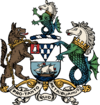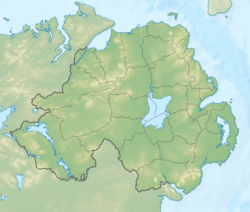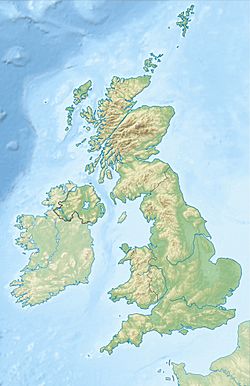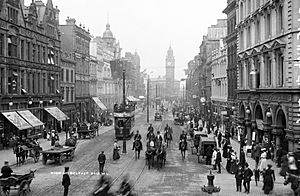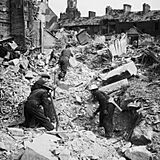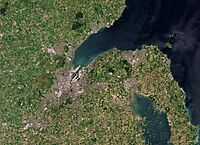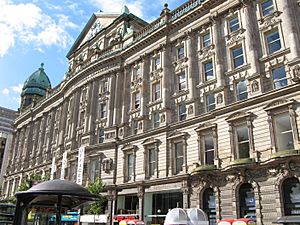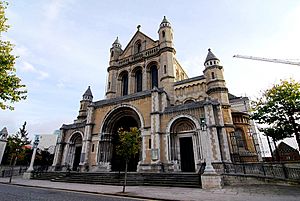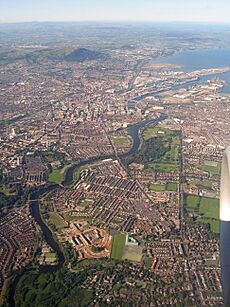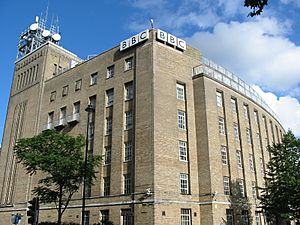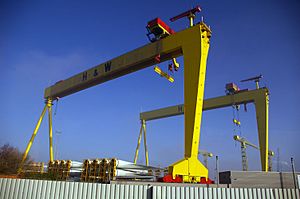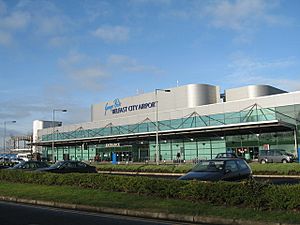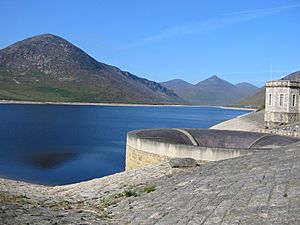Belfast facts for kids
Quick facts for kids
City of Belfast
|
||
|---|---|---|
|
||
| Motto(s): | ||
| Sovereign state | United Kingdom | |
| Country | Northern Ireland | |
| Incorporated | 1 April 2015 | |
| Administrative HQ | City Hall | |
| Government | ||
| • Type | District council | |
| • Body | Belfast City Council | |
| Area | ||
| • Total | 51 sq mi (133 km2) | |
| Area rank | 11th | |
| Population
(2022)
|
||
| • Total | 348,005 | |
| • Rank | 1st | |
| • Density | 6,780/sq mi (2,617/km2) | |
| Time zone | UTC+0 (GMT) | |
| • Summer (DST) | UTC+1 (BST) | |
| Postcode areas |
|
|
| Dialling codes | 028 | |
| ISO 3166 code | GB-BFS | |
| GSS code | N09000003 | |
Belfast is the capital city and main port of Northern Ireland. It sits on the banks of the River Lagan and connects to the sea through Belfast Lough. It is the second-largest city in Ireland after Dublin. In 2021, about 345,418 people lived in Belfast. Its wider metropolitan area has a population of 634,600.
Belfast was first set up as an English settlement in 1613. It grew quickly with many Scottish Presbyterians moving there. By 1888, when it became a city, Belfast was the world's biggest center for making linen. In the early 1900s, its shipyards built a huge part of all ships in the United Kingdom.
Over time, there were tensions between different groups in the city. These tensions led to periods of violence, especially from the late 1960s. The British Army was often on the streets during this time. Today, some areas are still separated by "peace lines," which are barriers.
Since the Good Friday Agreement in 1998, Belfast has become more peaceful. The city has grown a lot in the services sector, especially in finance, tourism, and film. It still has a port with docks and shipyards. Belfast is unique because it can trade goods freely with both British and European markets.
The city has two airports: George Best Belfast City Airport and Belfast International Airport. It also has two universities: Ulster University and Queen's University. In 2021, UNESCO named Belfast a City of Music.
Contents
History of Belfast
What's in a Name?
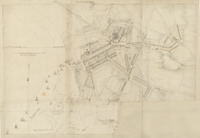
The name Belfast comes from the Irish words Béal Feirste. This means "Mouth of the Farset". The River Farset had a sandbar or a shallow crossing point where it met the River Lagan. The early town grew up around this crossing.
People who speak Ulster-Scots sometimes call Belfast Bilfawst, Bilfaust, or Baelfawst. Many places around the world, especially in the United States, are also named Belfast because people from the city moved there.
Early Settlements and Beginnings
People have lived in the Belfast area since the Bronze Age. You can find the Giant's Ring, a 5,000-year-old stone circle, nearby. Remains of Iron Age forts are also in the hills around the city.
In the 14th century, records show two churches in the area. One was near a "ford" or river crossing, which is where the city first started to grow. A Norman settlement, including a church and a small fort, was set up here in the late 1100s. This was an outpost of Carrickfergus Castle, a main English stronghold.
Growing Port and New Ideas
In 1613, Sir Arthur Chichester helped settle Belfast with English and Scottish people. Later, many Scottish Presbyterians moved in. These new settlers helped start the linen industry, which became very important for Belfast's trade with other countries.
In the 1700s, Belfast became a busy trading port. Ships carried goods like linen to the Americas. Profits from this trade helped improve the town's buildings and waterways, like the Lagan Canal. This made Belfast a major center for the linen trade.
Many Presbyterians in Belfast felt they were treated unfairly by the main church. They shared some feelings with the Catholic population. Inspired by the American and French Revolutions, some people in Belfast formed the Society of United Irishmen. They wanted fairer government and rights for all. In 1798, they led a rebellion, but it was defeated.
After this rebellion, Ireland joined with Great Britain in 1800 to form the United Kingdom. This union helped Belfast's industries grow even more.
Industry and Community Changes
From the 1820s, Belfast grew very fast as an industrial city. It became the world leader in making linen, earning the nickname "Linenopolis". Shipbuilding also became a huge industry. By the early 1900s, Belfast shipyards built a quarter of all ships in the UK. One famous ship built here was the RMS Titanic, launched in 1911.
These industries attracted many people, including a new Catholic population from poorer rural areas. This led to some tensions between different communities. Workers sometimes organized into groups like the Orange Order. These tensions often led to riots and arguments, especially about Ireland's future in the UK.
In 1912, many unionists gathered at Belfast City Hall to sign the Ulster Covenant. They promised to resist any plan for Ireland to have its own parliament. This led to the creation of the Ulster Volunteer Force (UVF). The start of World War I put a pause on these tensions. Many UVF members joined the army and fought bravely in battles like the Battle of the Somme.
In 1920–22, Belfast became the capital of Northern Ireland. During this time, there was violence, and many workers lost their jobs. The city had a curfew until 1924. In the 1930s, many people were unemployed, and there were protests. The city also suffered from poor health conditions.
The Blitz and After the War
In 1941, during World War II, German planes bombed Belfast twice. This event, known as the Belfast Blitz, caused a lot of damage to homes and the city center. Over a thousand people died, making it one of the deadliest air raids outside London.
After the war, the government started programs to clear old, damaged housing and build new homes on the city's edges. They also improved education and healthcare. These changes led to new hopes and also new protests in the 1960s about civil rights.
The Troubles and Peace
The protests of the 1960s soon turned into a period of conflict known as The Troubles. This involved violence between different groups. The British Army was sent to the streets in 1969 and stayed for many years. There were bombings, especially in Belfast's city center.
In 1998, the Good Friday Agreement was signed. This agreement brought a new power-sharing government to Northern Ireland. It helped bring an end to the main period of conflict. During The Troubles, about 1,500 people in Belfast were killed and 20,000 injured.
A lasting sign of the conflict is the "peace lines," which are barriers separating some communities. Efforts are being made to remove these barriers with agreement from local people.
Belfast in the 21st Century
Since 2000, Belfast's city center has grown a lot. There are more jobs in the service economy, and new areas like the Titanic Quarter have been developed. Tourism has also boomed, with visitors coming to see attractions like the murals and peace walls.
The city's population has also changed. Many new immigrants have moved to Belfast. Also, more young people are choosing not to identify with the traditional community divisions.
In 1997, for the first time, unionists lost overall control of Belfast City Council. In 2011, Irish nationalist councillors became the largest group.
In the 2016 Brexit referendum, Belfast voted to stay in the European Union. After Brexit, Belfast and Northern Ireland have a special status. They can trade goods freely with both the British and European markets. This is seen as a big opportunity for the city's economy.
Cityscape
Location and Landscape
Belfast is located where the River Lagan meets Belfast Lough. This lough connects to the Irish Sea. Over the years, the river and lough have been changed to create a deep-sea port and large shipyards. The River Lagan now has a weir that keeps its water level high.
Much of the city center is built on soft ground made of silt and clay. This can make building tall structures tricky. The city center is also at risk of tidal flooding.
Hills surround Belfast. On the north and northwest, you can see Divis Mountain, Black Mountain, and Cavehill. To the south and southeast are the lower Castlereagh and Hollywood hills.
North Belfast and Shankill
From the 1820s, Belfast began to expand quickly. To the north, it grew along roads that brought people from County Antrim into the city. This area includes places like New Lodge, Ardoyne, and the Shankill Road.
The Greater Shankill area is separated from other parts of Belfast by peace walls. These barriers are very tall, with one being "three times higher than the Berlin Wall". These walls have gates that open during the day.
Many old, terraced houses in Shankill were replaced with new buildings, but this led to many residents moving away. Roads like the M1 motorway and the Westlink also changed the area, cutting off some communities from the city center.
New housing estates were built on the city's edges. One large development, Rathcoole, became a loyalist community. In 2004, it was estimated that almost all public housing in Belfast was divided by religion.
Key landmarks in North Belfast include Crumlin Road Gaol, Belfast Royal Academy, St Malachy's College, and Belfast Zoo.
West Belfast
In the mid-1800s, many Catholic families moved to Belfast from rural areas. They settled along the Falls Road. This area, including places like Andersonstown, became mostly Catholic and nationalist.
Many women found jobs in mills, as domestics, or in shops. Education and public health also grew here. St Mary's Training College opened in 1900, and the Royal Victoria Hospital opened in 1903.
Important landmarks in West Belfast include St Peter's Cathedral, Clonard Monastery, and Milltown Cemetery. The area is famous for its wall murals, which often show support for different causes around the world.
South Belfast
South Belfast is separated from West Belfast by railway lines and the M1 Motorway. This area began to grow in the 1840s and 50s, along the Ormeau and Lisburn roads, and the Malone Road. This area has many large houses and parks.
Some of the city's former industrial estates were redeveloped into public housing. New houses and apartments have also been built, making the area more densely populated.
Major landmarks include the Belfast City Hospital tower block and the Lagan Valley Regional Park. This park has a towpath that goes from the city center to Lisburn.
East Belfast
Ballymacarrett was the first area on the east side of the River Lagan to become part of Belfast in 1853. Harland & Wolff, with its famous Samson & Goliath cranes, was a major employer here. The Short Strand is a small nationalist area in East Belfast.
East Belfast grew from the Queens Bridge and Albert Bridge, along roads like the Newtownards Road and Holywood Road. Further out, the housing becomes less segregated by religion.
Modern attractions in East Belfast include CS Lewis Square, named after the famous author of The Chronicles of Narnia. The Titanic Belfast museum, which tells the story of the famous ship, is also a big draw. The Orange Order opened the Museum of Orange Heritage here in 2015.
City Centre
Belfast City Centre is surrounded by roads built since the 1970s. It includes "the Markets" area, which still has some housing. Only one of the original markets, St George's, remains. It is now a popular food and craft market.
Old Buildings and Architecture
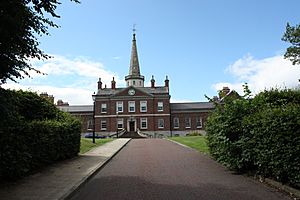
Belfast has many old buildings. The Belfast Entries are 17th-century alleyways off High Street. Other old buildings include the First Presbyterian Church (1781–83) and St George's Church (1816). The oldest public building is Clifton House (1771–74), which was a poorhouse.
Many beautiful Victorian buildings have survived bombings and development. These include St Malachy's Roman Catholic Church (1844), the original building of Queen's University Belfast (1849), and the Palm House in the Botanic Gardens (1852). The Ulster Hall (1862) and the Grand Opera House (1895) are also notable. The Crown Liquor Saloon (1885, 1898) is a famous Victorian pub.
City Hall was finished in 1906. It was built to show Belfast's importance after it became a city in 1888. Its design influenced buildings in India and South Africa.
St Anne's Church of Ireland Cathedral was consecrated in 1904. A tall stainless steel "Spire of Hope" was added in 2007. The Royal Courts of Justice opened in 1933.
City Centre Changes
The Victoria Square Shopping Centre opened in 2008, showing how the city center was recovering. However, fewer people are shopping in the city center now due to online shopping. Tourism and new hotels are helping to make up for this.
New homes are being built along the city's quays and in the Titanic Quarter. Ulster University has also expanded its Belfast campus, bringing many students and staff into the city.
Some people in Belfast sleep rough on the streets. In 2022, about 26 rough sleepers were identified. Many more people are experiencing homelessness and living in temporary shelters.
Belfast's "Quarters"
Since 2001, Belfast has promoted several cultural "quarters" to attract tourists.
- The Cathedral Quarter is the old trade area around St Anne's Cathedral. It has many bars, restaurants, and performance spaces. It hosts an annual arts festival.
- The Gaeltacht Quarter is where Irish-speaking Belfast is centered, around the Falls Road. It has the Cultúrlann McAdam Ó Fiaich cultural center.
The Linen Quarter is south of City Hall. It used to have linen warehouses but now has hotels, cafés, and cultural venues like the Grand Opera House.
- Further south is the Queen's Quarter, home to Queen's University, Botanic Gardens, and the Ulster Museum.
- The Titanic Quarter is a redeveloped area near Belfast Harbour. It is named after the RMS Titanic, which was built here. It has the Titanic Belfast museum and film studios.
Culture
Arts and Festivals
Belfast has many cultural places. The Linen Hall Library (1788), the Ulster Museum (1833), and the Botanic Gardens (1828) are all important. The Botanic Gardens host outdoor events like the Belfast Melā, a festival of global cultures.
The Ulster Hall (1862) hosts concerts, and the Grand Opera House (1895) stages plays. The Queens Film Theatre (1968) shows art house movies. These cinemas also host the Belfast Film Festival and the Belfast International Arts Festival.
The main theater for plays is the Lyric Theatre (2011). The SSE Arena (2000) is a large venue for concerts and events. The Waterfront Hall (1997) is another big center for conferences and entertainment. The Metropolitan Arts Centre, or "MAC", opened in 2012 and offers music, theater, and art.
Féile an Phobail is a community arts group that puts on one of Europe's largest community festivals in West Belfast.
UNESCO City of Music
In November 2021, Belfast was named a City of Music by UNESCO. This means it's recognized for its rich music scene.
Belfast's pubs and clubs often feature Irish traditional music. The city also has a strong history of punk music. The Oh Yeah music centre supports young musicians in various genres. Queen's University has the Sonic Arts Research Centre (SARC) for music research.
Media in Belfast
Belfast is home to several newspapers, including the Belfast Telegraph, Irish News, and The News Letter, which is the oldest English-language daily newspaper still published.
The city is also where BBC Northern Ireland and UTV (an ITV station) are based. RTÉ, the Irish public broadcaster, also has a studio here. Local radio stations include BBC Radio Ulster, Q Radio, and Raidió Fáilte (an Irish-language station).
Parades and Celebrations
Parades are a big part of Belfast's calendar. The Orange parades on "the Twelfth" (of July) celebrate history and culture. These parades often involve bands and marchers. While some smaller marches have had issues in the past, most events now happen peacefully. The Museum of Orange Heritage in East Belfast shares the history of this tradition.
Saint Patrick's Day (17 March) is celebrated with a carnival and parade in the city center. This event is organized by Féile an Phobail and features dancers, floats, and puppets.
Belfast also hosts a gay pride event, Belfast Pride, at the end of July. It is one of the largest LGBT+ festivals in Ireland. The Irish Congress of Trade Unions organizes an annual May Day march and rally.
Demography
In 2021, Belfast had 345,418 residents. The wider Belfast Metropolitan Area had 634,600 people, which is about one-third of Northern Ireland's total population.
Like many cities, Belfast's inner city has more older people, students, and young single people. Families often live in the outer areas. Some parts of North and West Belfast have higher levels of poverty. These areas, like the Falls Road and Shankill Road, are still largely separated by religion.
The number of Protestants in the city has decreased, while the number of Catholics and people with no religion has increased. In 2021, 43% of residents were Catholic, and 36.45% were from a Protestant or other Christian background.
People can choose more than one national identity. In 2021, 35% identified as "Irish only," 27% as "British only," and 17% as "Northern Irish only."
About 14.93% of people in Belfast have some knowledge of the Irish language, and 5.21% can speak, read, and write it. About 7.17% have some knowledge of Ulster Scots.
Belfast has growing immigrant communities, with Poles, Chinese, and Indians being the largest groups. In 2021, 9.8% of the city's residents were born outside the United Kingdom.
Economy
Most jobs in Belfast are in the services sector, including retail, health, and professional services. Only 6% of jobs are in manufacturing. Unemployment has been low recently, but many people are not working due to long-term health issues or disabilities.
Old Industries and New Beginnings
Very little remains of Belfast's old industries. The last linen factory closed in 2013. Harland & Wolff, once a huge shipyard, now has a smaller workforce. However, a new contract with the Royal Navy means it will return to shipbuilding in 2025.
In 1936, Short & Harland Ltd began making aircraft in the docks area. This company, now called Spirit AeroSystems, is still the largest manufacturing business in Northern Ireland. Since 2001, Thales Group has been making missiles in Belfast.
Technology and Film
Since the 1990s, Belfast has become a key location for financial technology (fintech) and other office services. Many large US companies have set up operations here. Queen's University has a center for cybersecurity research, which helps support this growing sector.
Between 2018 and 2023, film and television production in Belfast contributed £330 million to Northern Ireland's economy. The city has large studios, like Titanic Studios, which have attracted major companies like HBO (who filmed Game of Thrones here). In May 2025, Belfast was named "City of Film" at the Cannes Film Festival.
Tourism and Trade
Since the 1990s, Belfast has seen a big increase in tourism. This has led to many new developments, including the Victoria Square Shopping Centre, the Cathedral Quarter, and the Titanic Quarter with its Titanic Belfast visitor attraction.
Tourism has boomed, with 32 million visitors between 2011 and 2018. The city's port now welcomes many cruise ships. In 2023, Belfast had 153 cruise ship visits, bringing 320,000 passengers. A new deep-water quay is planned to welcome even larger ships.
Belfast is unique because it can trade goods freely with both British and European markets. This special status is seen as a big opportunity for businesses in the city.
Education
Schools in Belfast
Children from Catholic and Protestant families in Belfast mostly attend separate schools. These are called Maintained Schools (Catholic) and Controlled Schools (non-Catholic/Protestant). They follow the same curriculum, but teachers are trained separately.
Since the 1980s, Integrated schools have emerged. These schools bring together children and staff from both communities. There are also Irish language medium schools.
Belfast has 18 selective grammar schools. These schools select students based on academic ability. This system is different from many other cities in Great Britain.
The Education Authority is responsible for 156 primary and 48 secondary schools in Belfast. There are differences in how well students do in school. About 30% of school leavers do not achieve good exam results.
Colleges and Universities
Belfast Metropolitan College ("Belfast Met") is a further education college. It offers many vocational courses. It is one of the largest colleges in the UK, with over 53,000 students.
Belfast has two universities. Queen's University Belfast was founded in 1845. It is a large research-focused university with over 25,000 students, including many international students.
Ulster University has a campus in Belfast. Since 2021, this campus has been greatly expanded. This project aims to bring 15,500 staff and students into the city center and create 5,000 new jobs.
Governance
Belfast became a borough in 1613 and an official city in 1888. Since 1973, it has been a local government district managed by Belfast City Council.
Belfast is represented in the British House of Commons (the UK Parliament) and the Northern Ireland Assembly.
Local Government
Belfast City Council is in charge of many services, including planning, parks, and cultural heritage. The city's main officials are the Lord Mayor of Belfast, Deputy Lord Mayor, and High Sheriff. These positions rotate among the largest political groups on the council.
The first Lord Mayor of Belfast was in 1892. For many years, all mayors were unionists. The first nationalist Lord Mayor was Alban Maginness in 1997. The current Lord Mayor is Micky Murray of the Alliance Party. The Lord Mayor leads council meetings and represents the city.
In 1997, unionists lost overall control of the City Council for the first time. In 2023, unionists held 17 out of 60 seats. Nationalists held fewer than half, and other parties like the Alliance Party held the balance of power.
Northern Ireland Assembly and UK Parliament
As the capital, Belfast is home to the Northern Ireland Assembly at Stormont. This is where Northern Ireland's local government makes laws.
Belfast is divided into four areas for elections: Belfast North, Belfast West, Belfast South and Mid Down, and Belfast East. Each area sends one MP to the UK Parliament in Westminster. For the NI Assembly, each area sends five MLAs to Stormont.
In the 2022 Assembly elections, Belfast elected MLAs from several parties. In the 2024 UK general election, the DUP won Belfast East, while Sinn Féin won Belfast North and the SDLP won Belfast South.
Infrastructure
Hospitals
The Belfast Health & Social Care Trust manages healthcare in the city. Belfast has many specialist hospitals.
The Royal Victoria Hospital provides general and specialist services, including heart surgery. The Children's Hospital (Royal Belfast Hospital for Sick Children) provides care for children.
The Belfast City Hospital is a specialist center for blood diseases and cancer. It also has a kidney transplant center. Musgrave Park Hospital specializes in bone, joint, and muscle problems. The Mater Hospital provides a range of services to North Belfast. The Ulster Hospital on the eastern edge of the city is a major hospital for that area.
Transport
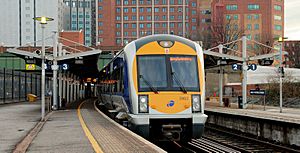
Belfast relies a lot on cars, with a large road network including the M2 and M22 motorways.
Black taxis are common, and private hire taxis are also popular. Public transport is run by Translink. Translink Metro buses connect residential areas to the city center. Ulsterbus serves more distant suburbs.
Northern Ireland Railways provides train services to nearby towns like Carrickfergus and Bangor. There is also a direct train connection to Dublin called Enterprise. In 2024, a new Belfast Central Station replaced the old Europa Bus Centre and Great Victoria Street rail station. It is the largest combined transport facility in Ireland.
Belfast has two airports: George Best Belfast City Airport (close to the city) and Belfast International Airport (further west). Both offer flights within the UK and to Europe. Dublin Airport is also nearby for international connections.
The Belfast Port offers ferry services to Cairnryan in Scotland and Liverpool-Birkenhead in England. There is also a seasonal ferry to the Isle of Man.
The Glider bus service, introduced in 2018, is a fast bus system connecting East Belfast, West Belfast, and the Titanic Quarter to the city center. It has been very popular and has helped modernize public transport.
Utilities
Half of Belfast's water comes from the Silent Valley Reservoir in the Mourne Mountains. The other half comes from Lough Neagh. Residents pay for water through their property taxes.
Electricity is supplied by NIE Networks Limited. Almost half of Northern Ireland's electricity comes from renewable sources. Phoenix Natural Gas Ltd. has been supplying natural gas to Belfast since 1996.
Recreation and Sports
Leisure Centres
Belfast City Council owns and maintains 17 leisure centers. These are run by a non-profit organization called GLL. Many of these centers have swimming pools and other facilities.
Parks and Gardens
Belfast has over forty parks. The oldest and most popular is Botanic Gardens (1828) in the Queen's Quarter. It has a beautiful Palm House, built in the 1830s, and a restored Tropical Ravine.
Ormeau Park is the largest municipal park, opened in 1871. In North Belfast, the Waterworks park has two reservoirs. Victoria Park is near the docks. The Connswater Community Greenway connects parks in East Belfast with walking and cycling paths.
The Lagan Valley Regional Park is a large green area along the River Lagan. It includes forests and the Sir Thomas and Lady Dixon Park, famous for its International Rose Garden.
Belfast Zoo is located below Cave Hill. It houses over 1,200 animals of 140 species, including elephants and gorillas. The zoo works to protect endangered species.
Sports
Belfast has many sports teams, playing football, Gaelic games, rugby, cricket, and ice hockey. The Belfast Marathon is held every May Day, attracting thousands of participants.
The Northern Ireland national football team plays its home games at Windsor Park. Many football clubs are based in the city, including Linfield and Glentoran.
Belfast has over twenty Gaelic football and hurling clubs. Casement Park in West Belfast is the home of the Antrim county teams. There are plans to rebuild it as a large stadium.
Ulster Rugby plays at Ravenhill Stadium. Belfast also has four rugby teams in the All-Ireland League.
The Stormont cricket ground has hosted international cricket matches. The SSE Arena is home to the Belfast Giants, a major ice hockey club.
Belfast is the hometown of famous sportspeople like footballer George Best. The City Airport is named after him. Other famous athletes include snooker champion Alex "Hurricane" Higgins and world champion boxers Wayne McCullough and Carl Frampton.
Climate
Belfast is in the north, so it has short winter days and long summer evenings. In winter, the sun sets before 4 PM, and in summer, it sets after 10 PM.
Thanks to the Gulf Stream, Belfast has a mild climate. Summer temperatures rarely go above 25°C (77°F), and winter temperatures rarely drop below -5°C (23°F). The city gets a good amount of rain, with about 157 rainy days a year.
Belfast's climate is called a temperate oceanic climate, which is common in northwest Europe.
| Climate data for Belfast (Newforge), elevation: 40 m (131 ft), 1991–2020 normals, extremes 1982–present | |||||||||||||
|---|---|---|---|---|---|---|---|---|---|---|---|---|---|
| Month | Jan | Feb | Mar | Apr | May | Jun | Jul | Aug | Sep | Oct | Nov | Dec | Year |
| Record high °C (°F) | 15.0 (59.0) |
16.4 (61.5) |
19.7 (67.5) |
22.1 (71.8) |
25.4 (77.7) |
28.6 (83.5) |
30.2 (86.4) |
28.1 (82.6) |
23.7 (74.7) |
20.5 (68.9) |
17.1 (62.8) |
15.2 (59.4) |
30.2 (86.4) |
| Mean daily maximum °C (°F) | 8.2 (46.8) |
8.8 (47.8) |
10.5 (50.9) |
12.8 (55.0) |
15.7 (60.3) |
17.2 (63.0) |
19.7 (67.5) |
19.4 (66.9) |
17.3 (63.1) |
13.8 (56.8) |
10.7 (51.3) |
8.4 (47.1) |
13.7 (56.7) |
| Daily mean °C (°F) | 5.2 (41.4) |
5.5 (41.9) |
6.8 (44.2) |
8.8 (47.8) |
11.4 (52.5) |
14.0 (57.2) |
15.6 (60.1) |
15.4 (59.7) |
13.5 (56.3) |
10.4 (50.7) |
7.4 (45.3) |
5.4 (41.7) |
9.9 (49.8) |
| Mean daily minimum °C (°F) | 2.2 (36.0) |
2.1 (35.8) |
3.1 (37.6) |
4.7 (40.5) |
7.0 (44.6) |
9.7 (49.5) |
11.6 (52.9) |
11.5 (52.7) |
9.6 (49.3) |
6.9 (44.4) |
4.2 (39.6) |
2.3 (36.1) |
6.3 (43.3) |
| Record low °C (°F) | −10.1 (13.8) |
−7.1 (19.2) |
−6.5 (20.3) |
−3.8 (25.2) |
−2.6 (27.3) |
1.3 (34.3) |
4.2 (39.6) |
2.5 (36.5) |
0.8 (33.4) |
−3.0 (26.6) |
−7.6 (18.3) |
−13.5 (7.7) |
−13.5 (7.7) |
| Average precipitation mm (inches) | 88.5 (3.48) |
70.3 (2.77) |
71.4 (2.81) |
60.4 (2.38) |
59.6 (2.35) |
69.0 (2.72) |
73.6 (2.90) |
85.0 (3.35) |
69.6 (2.74) |
95.8 (3.77) |
102.3 (4.03) |
93.3 (3.67) |
938.7 (36.96) |
| Average precipitation days (≥ 1.0 mm) | 14.4 | 12.7 | 12.6 | 11.3 | 11.5 | 11.4 | 13.0 | 13.5 | 11.6 | 13.8 | 15.5 | 14.8 | 156.2 |
| Mean monthly sunshine hours | 40.1 | 65.2 | 97.7 | 157.1 | 185.1 | 151.1 | 146.3 | 141.9 | 112.0 | 92.4 | 52.9 | 35.3 | 1,277 |
| Source 1: Met Office | |||||||||||||
| Source 2: Starlings Roost Weather | |||||||||||||
Images for kids
-
.
Percentage Catholic or brought up Catholic
-
.
Most commonly stated national identity
-
.
Percentage born outside the UK and Ireland
Notable People from Belfast
- Thomas Andrews (1873–1912), chief naval architect for the Titanic.
- George Best (1946–2005), famous football player.
- Kenneth Branagh (born 1960), actor and director.
- Ciaran Carson (1948–2019), writer and poet.
- Edward Carson (1854–1935), important political leader.
- William Conor (1881–1968), painter of working-class life.
- Henry Cooke (1788–1868), Presbyterian leader.
- James Craig (1871–1940), first Prime Minister of Northern Ireland.
- William Drennan (1754–1820), founder of Royal Belfast Academical Institution.
- Linda Ervine (born 1960s), Irish-language supporter.
- Harry Ferguson (1884–1960), invented the modern agricultural tractor.
- Carl Frampton (born 1987), world champion boxer.
- John Hewitt (1907–1987), poet.
- Alex "Hurricane" Higgins (1949–2010), world snooker champion.
- Terri Hooley (born 1948), key figure in Belfast's punk music scene.
- Otto Jaffe (1846–1929), Jewish community leader and former Mayor.
- William Johnston (1829–1902), Orangeman and politician.
- Lord Kelvin (1824–1907), famous physicist.
- Louise Kennedy (born 1978), writer.
- C. S. Lewis (1898–1963), author of The Chronicles of Narnia.
- Michael Longley (born 1939), poet.
- Mary Ann McCracken (1766–1866), social activist and abolitionist.
- Wayne McCullough (born 1970), world champion boxer.
- Bernard MacLaverty (born 1942), writer.
- Mairéad Corrigan (born 1944), Nobel Peace Prize winner.
- James Mason (1909–1984), actor, starred in Odd Man Out.
- Rinty Monaghan (1918–1984), world champion boxer.
- Brian Moore (1921–1999), novelist.
- Van Morrison (born 1945), famous singer-songwriter.
- Ian Paisley (1926–2014), founder of the DUP.
- William Pirrie (1847–1924), Chairman of Harland & Wolff.
- Betty Sinclair (1910–1981), Communist party activist and civil rights leader.
- David Trimble (1944–2022), Ulster Unionist leader and Nobel Peace Prize winner.
- Ernest Walton (1903–95), Nobel Prize winner for splitting the atom.
Sister Cities
Belfast is twinned with these cities:
- Nashville, Tennessee, United States (since 1994)
- Hefei, Anhui, China (since 2005)
- Boston, Massachusetts, United States (since 2014)
- Shenyang, Liaoning, China (since 2016)
- Melbourne, Victoria, Australia
Freedom of the City
These people have received the Freedom of the City of Belfast:
- Sir Kenneth Branagh: 30 January 2018.
- Andrew Carnegie: 28 September 1910.
- Sir Winston Churchill: 16 December 1955.
- Bill Clinton, 9 April 2018
- Sir Robert Hart, 1 July 1908
- John Hewitt: 26 May 1983
- Sir John Jordan: 28 September 1910.
- Michael Longley: 23 March 2015
- George J. Mitchell, 9 April 2018
- Nurses of Belfast, 1 December 2015
- Royal Ulster Constabulary and Reserve: 30 May 1980
- William Pirrie, 1st Viscount Pirrie: 1898, the first person to be awarded Freedom Of The City of Belfast.
See also
 In Spanish: Belfast para niños
In Spanish: Belfast para niños









